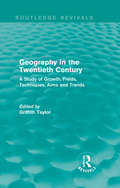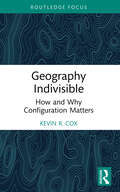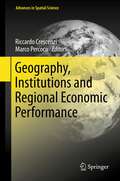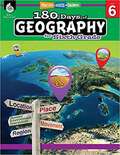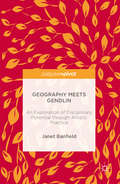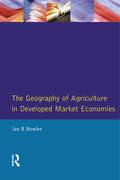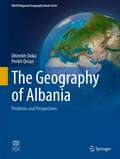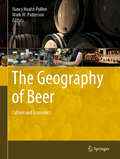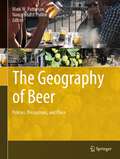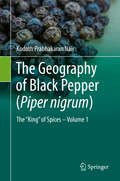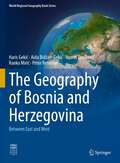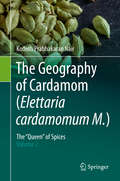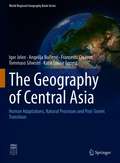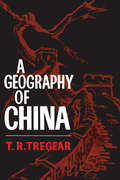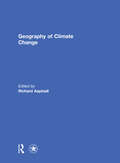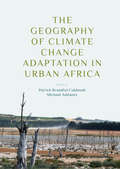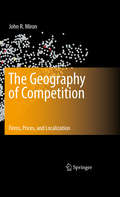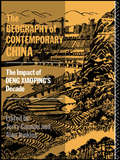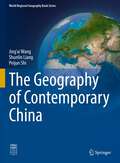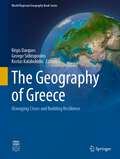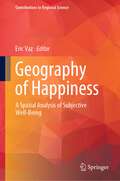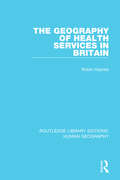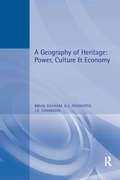- Table View
- List View
Geography in Classical Antiquity
by Daniela Dueck a chapter by Kai BrodersenWhat were the limits of knowledge of the physical world in Greek and Roman antiquity? How far did travellers get and what did they know about far-away regions? How did they describe foreign countries and peoples? How did they measure the earth, and distances and heights on it? Ideas about the physical and cultural world are a key aspect of ancient history, but until now there has been no up-to-date modern overview of the subject. This book explores the beginnings and development of geographical ideas in Classical antiquity and demonstrates technical methods for describing landscape, topographies and ethnographies. The survey relies on a variety of sources: philosophical and scientific texts but also poems and travelogues; papyrological remains and visual monuments.
Geography in the Twentieth Century: A Study of Growth, Fields, Techniques, Aims and Trends (Routledge Revivals)
by Griffith TaylorThis title, first published in 1951, examines the growth, fields, techniques, aims and trends of geography at the time. The book is divided into three parts, of which the first deals with the evolution of geography and its philosophical basis. The second is concerned with studies of special environments and with advances in geomorphology, meteorology, climate, soils and regionalism. The last part describes field work, sociological and urban aspects, the function of the Geographical Society and geo-pacifics. Geography in the Twentieth Century will be of interest to students of both physical and human geography.
Geography Indivisible: How and Why Configuration Matters
by Kevin R. CoxIn a context of disciplinary division between human and physical geography, the book seeks to reassert the unity of the field through an emphasis on a shared focus on the geographic configuration of things and how and why configuration is important. It first examines previous approaches to reestablishing unity, and why they have failed, before moving on to an explanation of fundamental differences in what is being studied and how. The role of configuration looms large in both. This is in the sense of contingency and the idea of emergence, suggesting that reconstruction of unity can proceed through an exchange of models of understanding. This book will appeal to those teaching courses or seminars in geographic thought or in the history of geographic thought.
Geography, Institutions and Regional Economic Performance
by Marco Percoco Riccardo CrescenziThe book aims to present "traditional features" of regional science (as geographical concepts and institutions), as well as relatively new topics such as innovation and agglomeration economies. In particular it demonstrates that, contrary to what has been argued by recent economics literature, both geography and institutions (or culture) are relevant for local development. In fact, these phenomena, along with the movement of goods and workers, are among the main reasons for persisting development differentials. These intriguing relationships are at the heart of the analysis presented in this book and form the conceptual basis for a promising institutional approach to economic geography.
Geography, Level 6: Practice, Assess, Diagnose
by Jennifer EdgertonSupplement your social studies curriculum with 180 days of daily geography practice! This essential classroom resource provides teachers with weekly geography units that build students' geography knowledge, and are easy to incorporate into the classroom. <p><p> In a world that is becoming more connected and globalized, 21st century students must have the skills necessary to understand their world and how geography affects them and others. Students will develop their map and spatial skills, learn how to answer text- and photo-dependent questions, and study the 5 themes of geography. Each week covers a particular topic and introduces students to a new place or type of map. <p><p> The first two weeks consist of a mini-unit that focuses entirely on map skills. For additional units, students will study various places, and how culture and geography are related. With a focus on the six populated continents, students will explore various types of maps including physical maps, political maps, topographic maps, thematic maps, climate maps, regional maps, and various topics including scale, legends, cardinal directions, latitude and longitude, and more. Aligned to state standards and National Geography Standards, this resource includes digital materials.
Geography Meets Gendlin
by Janet BanfieldThis book makes a timely and engaging contribution to geography's resurgent interest in art and artistic practice, as well as to growing geographical concerns with embodied or pre-reflective experience. It introduces Eugene Gendlin's philosophical and methodological work to stimulate geographical thinking and practice, and explores its disciplinary potential through innovative practice-based research into artistic spatial experience. Gendlin's philosophy and techniques for articulating the pre-reflective are explained and illustrated using artists' accounts of their practices, both retrospectively and during their practice. The geographical implementation of research methods informed by those techniques is detailed and critiqued. Diverse and potentially contradictory findings, and potentially problematic methodological choices, are discussed, accounted for, and reframed through Gendlin's ideas. Significant geographical potential within Gendlin's work--philosophical, conceptual and methodological--is identified and described, and avenues and challenges for further investigation are highlighted. This first step towards a Gendlin-informed geography invites further engagement with his work.
The Geography of Agriculture in Developed Market Economies
by I.R. BowlerFirst published in 1993. The broad objective of this book is to describe and explain the contemporary geography of agriculture in developed market economies. The objective has been approached by a team of agricultural geographers, each writer contributing an analysis of a particular topic.
The Geography of Albania: Problems and Perspectives (World Regional Geography Book Series)
by Dhimitёr Doka Perikli QiriaziThis book is the first to give a comprehensive and detailed overview of the complete geography of Albania in English. It highlights the most important and manifold potentials of nature, society and economy of Albania as well as development problems during different time periods. One focus lies on Albania's perspectives and challenges for the future.Beside natural aspects also topics such as migration, poverty, social situation, economy, urban development, regional disparities among others are discussed.This book appeals to academics and researchers of geography, regional development and related disciplines as well as teachers and students of geography, geology, natural sciences, social sciences, economics. The book is also attractive for media representatives, tourists and other interested individuals travelling to Albania.
The Geography of Beer: Culture and Economics
by Mark W. Patterson Nancy Hoalst-PullenThis book builds on the highly successful Geography of Beer: Regions, Environment, and Society (2014) and investigates the geography of beer from two expanded perspectives: culture and economics. The respective chapters provide case studies that illustrate various aspects of these themes. As the beer industry continues to reinvent itself and its economic and cultural geographies, this book showcases historical, current, and future trends at the local, regional, national, and international scales.
The Geography of Beer: Policies, Perceptions, and Place
by Mark W. Patterson Nancy Hoalst-PullenThis book focuses on the geography of beer in the contexts of policies, perceptions, and place. Chapters examine topics such as government policies (e.g., taxation, legislation, regulations), how beer and beerscapes are presented and perceived (e.g., marketing, neolocalism, roles of women, use of media), and the importance of place (e.g., terroir of ingredients, social and economic impacts of beer, beer clubs). Collectively, the chapters underscore political, cultural, urban, and human-environmental geographies that underlie beer, brewing, and the beer industry.
The Geography of Black Pepper (Piper nigrum): The "King" of Spices – Volume 1
by Kodoth Prabhakaran NairThis book considers all aspects of black pepper from its growth, as a flowering vine, to how the dried fruit (peppercorn) is used as a spice and traded as a commodity. It is the economic mainstay of several India states and, principally, in Kerala State, with the Indian subcontinent being the largest black pepper producer. Indonesia has also emerged as a large producer of black pepper. Black pepper commands a leading position among the spices and has an immense commercial importance to world trade, finding its way onto the dining table of millions around the world, on the European and North American continents, and Japan. The use of black pepper ranges from a simple dietary component and flavour enhancer, to that of a spice with huge pharmacological benefits.
The Geography of Bosnia and Herzegovina: Between East and West (World Regional Geography Book Series)
by Haris Gekić Aida Bidžan-Gekić Nusret Drešković Ranko Mirić Péter ReményiThis monograph provides a comprehensive overview of fundamental scientific insights into the geographical features of a country which was and still is in the centre of the geopolitical battle of the large world powers and especially neighboring countries. The book presents the scientifically proven reserves of individual resources such as: mineral riches, land, forests, flora and fauna, water and climate features, to the extent needed, through statistical indicators and geographic maps. The authors point to features and specifics of the existing interdependence of economic and political development and impact of natural resources on spatial development which can be useful for potential investors, spatial planers, decision makers, politicians, geographers, students, large Bosnian diaspora and anyone interested in area of Bosnia and Herzegovina. This book fills the gap in geographical literature on Bosnia and Herzegovina in the English language. The monograph appeals to researchers and scholars of all levels in the fields of geography, geopolitics, history and related fields and everyone interested in this country between East and West.
The Geography of Cardamom (Elettaria cardamomum M.): The "Queen" of Spices – Volume 2
by Kodoth Prabhakaran NairThis book catalogues the multi-scale impact of agronomy and economy on Cardamom, known as the “Queen” of spices. Cardamom is the second most important spice crop in the world, after Black pepper, known as the “King” of spices. Spices were the symbols of luxury and royalty, and cardamom was used in the manufacture of perfumes during the Greek and Roman times. It became one of the most important Oriental spices used in both Greek and Roman cuisine as well as its pharmacological applications. The book is divided into 15 chapters and concentrates on aspects of cardamom production and processing, the taxonomic aspects of cardamom, chemistry, pathology, entomology and is concluded with the future of cardamom. Special emphasis is given to the utility of “The Nutrient Buffer Power Concept”, a soil management technique in precise fertilizer management, especially with regard to Potassic fertilizers in cardamom production.
The Geography of Central Asia: Human Adaptations, Natural Processes and Post-Soviet Transition (World Regional Geography Book Series)
by Igor Jelen Angelija Bučienė Francesco Chiavon Tommaso Silvestri Katie Louise ForrestThis book provides a profound geographical description and analysis of Central Asia. The authors take a synthetic approach in a period of critical transformation in the post-soviet time. The monograph analyzes comprehensively the physical and human geography as well as human-nature interactions of Central Asia with focus on Kazakhstan, Uzbekistan, Turkmenistan, Kyrgyzstan and Tajikistan. Natural processes are described at a systemic scale, focusing on ecological impacts and consequences and contemporary human adaptations and organization. It also discusses in which ways the human organizations try to apply solutions for their needs such as security, territorial management and resources renewability, material and functional needs, identity elaborations, culture and communication. The Geography of Central Asia appeals to scientists and students of regional geography and interested academics from other areas such as social, political, economic and environmental studies within the context of Central Asia. The book is also a very useful resource for field trips into this area.
A Geography of China
by T.R. TregearThis book is intended primarily for serious students of geography but it will also appeal to the general reader. For this reason technical terms have been used as sparingly as is consistent with correct meaning. Wherever the subject matter permits, the author emphasizes geographical growth and shows the interaction of geographical environment and the human activity and institutions. When originally published in the 1960s China was beginning to change with breathtaking rapidity. These changes are presented here against geographical and historical background. Knowledge of the environmental facts is essential to an appreciation of the political, economic, and social problems that have faced the Chinese people.
Geography of Climate Change
by Richard AspinallClimate change is one of the inescapable themes of current times. Climate change confronts society in issues as diverse as domestic and international political debate and negotiation, discussion in the media and public opinion, land management choices and decisions, and concerns about environmental, social and economic priorities now and for the future. Climate change also spans spatial, temporal and organisational scales, and has strong links with nature-society relationships, environmental dynamics, and vulnerability. Understanding the full range of possible consequences of climate change is essential for informed decision making and debate. This book provides a collection of chapters that span environmental, social and economic aspects of climate change. Together the chapters provide a diverse and contrasting series that highlights the need to analyze, review and debate climate change and its possible impacts and consequences from multiple perspectives. The book also is intended to promote discussion and debate of a more integrated, inclusive and open approach to climate change and demonstrates the value of geography in addressing climate change issues.This book was originally published as a special issue of Annals of the Association of American Geographers.
The Geography of Climate Change Adaptation in Urban Africa
by Patrick Brandful Cobbinah Michael AddaneyThis book take a comprehensive look at several cases of climate change adaptation responses across various sectors and geographical areas in urban Africa and places them within a solid theoretical context. Each chapter is a state-of-the-art overview of a significant topic on climate change adaptation in urban Africa and is written by a leading expert in the field. In addition to the focus on the geography of urban adaptation to climate change in Africa, this collection offers a broader perspective by blending the use of case studies and theory based research. It examines transformations in climate change adaptation and its future orientation from the perspectives of urban planners, political economists, environmentalists, ecologists, economists and geographers, thereby addressing the challenges facing African cities adaptation responses from all angles. Providing up-to-date and authoritative contributions covering the key aspects of climate change adaptation in urban Africa, this book will be of great interest to policymakers, practitioners, scholars and students of geography, urban development and management, environmental science and policy, disaster management, as well as those in the field of urban planning.
The Geography of Climate Change Adaptation in Urban Africa
by Patrick Brandful Cobbinah Michael AddaneyThis book takes a comprehensive look at several cases of climate change adaptation responses across various sectors and geographical areas in urban Africa and places them within a solid theoretical context. Each chapter is a state-of-the-art overview of a significant topic on climate change adaptation in urban Africa and is written by a leading expert in the field. In addition to the focus on the geography of urban adaptation to climate change in Africa, this collection offers a broader perspective by blending the use of case studies and theory based research. It examines transformations in climate change adaptation and its future orientation from the perspectives of urban planners, political economists, environmentalists, ecologists, economists and geographers, thereby addressing the challenges facing African cities adaptation responses from all angles. Providing up-to-date and authoritative contributions covering the key aspects of climate change adaptation in urban Africa, this book will be of great interest to policymakers, practitioners, scholars and students of geography, urban development and management, environmental science and policy, disaster management, as well as those in the field of urban planning.
The Geography of Competition
by John R. MironThis book provides a comprehensive, up-to-date, and expert synthesis of location theory. What are the impacts of a firm's geographic location on the locations of customers, suppliers, and competitors in a market economy? How, when, and why does this result in the clustering of firms in space? When and how is society made better or worse off as a result? This book uses dozens of locational models to address aspects of these three questions. Classical location problems considered include Greenhut-Manne, Hitchcock-Koopmans, and Weber-Launhardt. The book reinterprets competitive location theory, focusing on the linkages between Walrasian price equilibrium and the localization of firms. It also demonstrates that competitive location theory offers diverse ideas about the nature of market equilibrium in geographic space and its implications for a broad range of public policies, including free trade, industrial policy, regional development, and investment in infrastructure. With an extensive bibliography and fresh, interdisciplinary approach, the book will be an invaluable reference for academics and researchers with an interest in regional science, economic geography, and urban planning, as well as policy advisors, urban planners, and consultants.
The Geography of Contemporary China: The Impact of Deng Xiaoping's Decade
by Terry Cannon Alan JenkinsDeng Xiaoping's rule has seen fundamental economic change in China. This book considers the impact of these years on China's physical environment, as well as its people, industry, agriculture and trade. It also assesses the contribution of a decade of Chinese politics towards geopolitics. The book provides an introduction to Communist China, setting its spatial and environmental themes in the historical, political and economic framework so crucial to a proper understanding of this country and the fifth of the world's population it contains. It is particularly suited to courses on China, its geography and development strategy. After the bloody events of Tiananmen Square in June 1989 China's geopolitics will continue to hold the world's attention. With this in view the book also provides guides to further reading.
The Geography of Contemporary China (World Regional Geography Book Series)
by Jing’ai Wang Shunlin Liang Peijun ShiThis textbook provides a comprehensive and very detailed insight into Chinese Contemporary Geography in English. It documents the geographical issues associated with China's rapid growth. Since initiating the reforms and open policy, China has achieved tremendous success. China's rapid growth is now a driving force in the global economy and is achieving unprecedented rates of poverty reduction. However, China also faces a number of sustainability and emerging challenges associated with rapid growth such as growing regional disparities in terms of per capita income and social-economic development, sustainable resource development, and issues related to regional and global economic integration. In addition, rapid economic growth has also brought about major challenges such as resource shortages, ecological and environmental destruction, land degradation and frequent disasters. This book presents the authors’ reflections. This lavishly illustrated book covers physical geography, history, and economic and political systems of the world's most populous country. The major focus is on geographical issues in China's contemporary development: agriculture, population, urbanization, resource and energy, and environment. The lead author of the book has taught relevant courses in China for three decades, and authored and edited multiple textbooks for Chinese students. This book will appeal to undergraduate students of geography and related disciplines with a regional focus on China and to the general reader who wants to learn different geographical aspects of modern China with little academic background in geography.
The Geography of Greece: Managing Crises and Building Resilience (World Regional Geography Book Series)
by Régis Darques George Sidiropoulos Kostas KalabokidisDuring the last few years, Greece has become a subject of increasing attention worldwide. Once praised for its ability to innovate and reform during the EU integration process, applauded for its remarkable job in managing the 2004 Olympics, the country fell into a financial crisis of unprecedented magnitude in 2008. Much has been said on this matter, and amid the morass of information a staggering number of untruths have been disseminated.In fact, the challenges of vulnerability and the paradigms of adaptation go way beyond finance and economy in Greece. Mega-fires, earthquakes, landslides and floods, migrations, sociopolitical upheavals, and armed conflicts generate emergency situations repeatedly. Because of its bridging role between natural and social sciences, geography can provide insights into the entire breadth of hazardous and chaotic events driving adaptation and change. Against all these threats, Greece has developed an enhanced resilience capacity. The purpose of this book is to help unravel the complexities of a fascinating country beyond clichés.This book is intended for students, researchers, scholars, and engineers interested in geography, land planning, urban studies, and environmental management. The crises issue intended as a guideline allows widening the audience to include the media, governmental and non-governmental agencies, and the public at large.
Geography of Happiness: A Spatial Analysis of Subjective Well-Being (Contributions to Regional Science)
by Eric VazThis book offers readers a spatial understanding of happiness and subjective well-being. By integrating spatial and geostatistical methods, it sheds new light on the spatial and geographical aspects of subjective well-being. Geographical analysis allows us to measure spatial and regional discrepancies in subjective well-being and to identify heterogeneous profiles in terms of social, economic and environmental patterns. Consequently, the papers gathered here address various topics concerning the spatial aspects of subjective well-being, including social injustice, age, new urban spaces, and tourism. The book proposes a multidisciplinary approach and is intended for scholars and students in the fields of geography, economics and the spatial sciences. By examining several critical dimensions of happiness and subjective well-being, it enriches the complexity of regional decision-making on the path toward happier and more liveable societies.
The Geography of Health Services in Britain. (Routledge Library Editions: Human Geography #9)
by Robin HaynesThis book is about geographical variation in the organisation, provision and use of health services in Britain. Its main theme is that neither the quantity nor the quality of health care provided by the National Health Service (NHS) is uniform from place to place. Chapters discuss and evaluate: The reorganisation of the NHS in the years up to 1987 The relationships between the need for health care and the supply of health services The redistribution of health service resources geographically The distribution of doctors, dentists, community nurses and hospitals across the UK Access to health services The distribution of both private health facilities and social welfare services and their effect on the NHS.
A Geography of Heritage: Power, Culture And Economy (A\hodder Arnold Publication)
by Brian Graham Greg Ashworth John TunbridgeThe concept of heritage relates to the ways in which contemporary society uses the past as a social, political or economic resource. However, heritage is open to interpretation and its value may be perceived from differing perspectives - often reflecting divisions in society. Moreover, the schism between the cultural and economic uses of heritage also gives rise to potential conflicts of interest. Examining these issues in depth, this book is the first sustained attempt to integrate the study of heritage into contemporary human geography. It is structured around three themes: the diversity of use and consumption of heritage as a multi-sold cultural and economic resource; the conflicts and tensions arising from this multiplicity of uses, producers and consumers; and the relationship between heritage and identity at a variety of scales.

